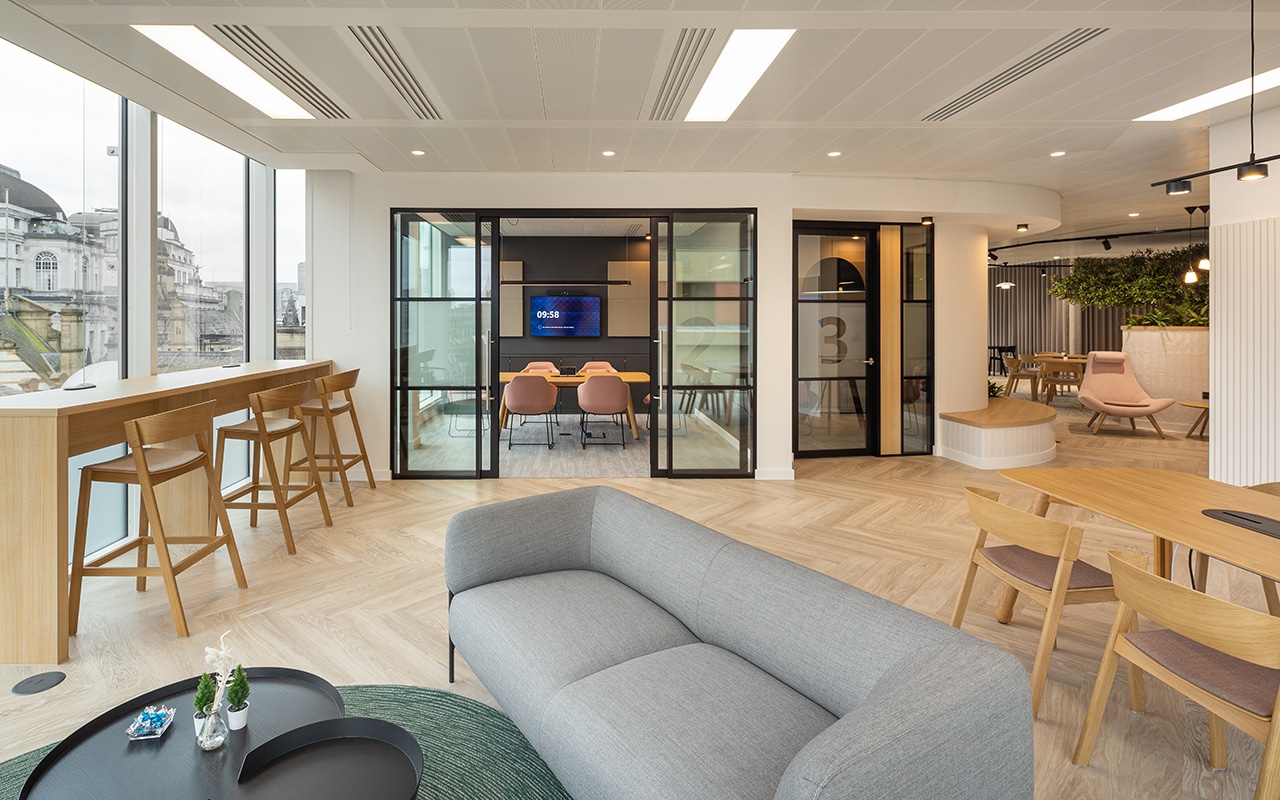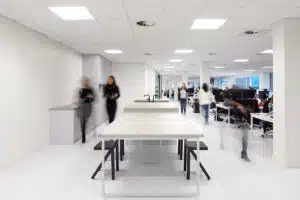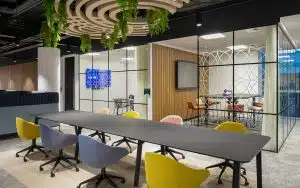Collaboration in the workplace is about encouraging participation between team members, promoting the sharing of thoughts, skills and knowledge. When employees come together, they’re more likely to identify and overcome challenges and produce more effective, creative and diverse ideas for better outcomes.
With the rise of hybrid working arguably presenting challenges when it comes to collaboration, it’s becoming even more important for employees to utilise time when they are face-to-face with their colleagues to its full potential.
This relies on optimising the workplace environment for collaboration. Whether you’re creating an office space from scratch or rethinking and refurbishing an existing one, there are plenty of design and layout tools, features and ideas that businesses can implement to improve collaboration in the workplace and drive wider benefits.
What are the benefits of collaboration in the workplace?
Collaborative office design brings lots of benefits to employees and the wider business, proving that it’s worth putting in the time and resource. Companies that invest in promoting collaboration in the workplace typically notice:
- Greater productivity: Pooling skills, knowledge, ideas and brainpower boosts the collective capability of the team, making completing a task or overcoming a problem much quicker and easier. In fact, a Stanford study found that individuals working in a collaborative rather than an individual setting complete tasks 50% more effectively.
- Creativity and innovation: The more people working together results in a more diverse range of experiences and perspectives to draw upon. By bringing different working styles and personalities together, employees can challenge and bounce off each other to come up with new and innovate ideas and solutions .
- Knowledge sharing and development: Employees expand their knowledge and skillsets by working with other people, and benefit from a wider range of unique insights and experiences. This aids personal and professional development and strengthens the organisation as a whole, while making efficient use of internal skills, knowledge and resources.
- Better teamwork: As philosopher Aristotle said, ‘the whole is greater than the sum of its parts’. Encouraging employees to work together towards a common goal or purpose not only betters the outcome or speeds up the journey, but it can also strengthen relationships and improve morale, helping employees feel part of a shared vision.
- Company culture: Collaborative office space is also more conducive to a positive company culture because it helps to create a more open, friendly and welcoming environment for employees. It demonstrates that they can raise issues or challenges and get help from colleagues to overcome them, reinforcing a sense of community and belonging. This, in turn, boosts morale, satisfaction and retention.
All of these benefits drive better outcomes for businesses, with research from the Institute of Collaborative Working showing that collaboration can lead to increased sales, customer satisfaction ratings, product quality and product development.
Workplace settings to support collaboration
So, how do you improve collaboration in the workplace? It’s important to remember that there’s no cookie cutter approach to creating a collaborative workplace. Requirements differ from company to company. At ADT Workplace, we always start by understanding your business and listening to your people in order to create an effective solution.
The office design should take personal preferences into account. People have different working styles and preferred settings, which can change depending on the task they’re working on and their mood. This is why it’s important to offer a range of agile and flexible working environments, giving employees the choice and space to work how they choose and move around freely. Workplace settings and ideas that support collaboration include:
- Intelligently designed team zones or neighbourhoods where teams can connect and communicate easily and work effectively together. Employees working in close proximity can quickly and easily share solutions and ideas, and naturally learn by overhearing conversations and spending time in the same environment as colleagues.
This can also help to foster a sense of teamwork and community, strengthening team relationships. However, it’s also important not to create organisational silos as these can be one of the main barriers to collaboration in the workplace – you might instead to mix teams up. This ‘intersection’, according to Frans Johansson, author of The Medici Effect, can be where some of the most innovative ideas happen. - Open collaboration areas: You can place these in communal areas and they should offer more casual and relaxed settings. While standard chairs and tables are practical, adding comfortable and flexible seating enhances the space.
For example, a modular sofa can easily reconfigure as required for a meeting and be put back together into one tidy and compact unit afterwards. Introducing stand-up tables encourages team members to move around, interact with each other and stay focused on the task in hand. - Creative brainstorm areas: We design these areas to promote interaction and harness innovation. Consider adding a media wall to allow employees to easily display multimedia content, share ideas and visualise concepts.
- Larger areas for group collaboration: Factoring bigger areas for collaboration into your office design means you can support larger group discussions and meetings, and it can also double up as an events space for team presentations or guest speakers. Utilise tiered or bleacher-style seating (like we used for x+why Manchester) to make efficient use of space and ensure everyone has a good view of the presentation area. Opt for modular and reconfigurable style-seating, or double it up as a space-saving storage solution.
- Breakout rooms and social/games areas: These more relaxed and fun spaces encourage social interaction and team bonding away from work. Incorporating games and recreational activities encourages employees to take breaks and unwind so they return to their work with a fresh mindset. These shared amenities promote collaboration between teams by facilitating chance encounters and bringing employees together when their paths wouldn’t normally cross.
- Private/calm spaces: Collaborative and social areas bring many benefits and can help to create a vibrant and busy office environment, but it’s equally important to ensure employees have access to private and calm space too, such as meditation or relaxation rooms. Providing private and calm spaces is important for open plan offices, especially for neurodivergent employees that might need to take timeout to manage stress and sensory overload.
As well as a variety of casual and open collaboration spaces, there should also be spaces for more formal and private meetings, including:
- Meeting rooms: You’ll likely need some private space, separate from the main office, for private meetings to take place. More formal appointments, interviews, personal reviews and appraisals, and other meetings that require privacy are all more suited to this type of environment. Consider introducing moveable partitions to make meeting spaces more practical and flexible, allowing you to adapt the space to different group sizes.
- Meeting pods: Formal meetings rooms aren’t the only solution for private discussions. Dedicated meeting pods with glazing and acoustic panelling can be a useful addition to open office space, giving employees another option for smaller meetings or a quiet space to take video calls.
Office layouts and floor plan considerations for a collaborative workplace
Getting the floor plan and office layout right is a big part of collaborative office space design. Key considerations include:
- Effective zoning to allow for collaboration, social and communal office space as well as settings for privacy, focus and calm. It’s important to get the balance right and ensure that the different areas work effectively without encroaching on each other. Consider introducing additional glazing, curtains or acoustic panelling to ensure the different areas with varying noise levels can co-exist effectively.
- Removing barriers and internal walls. By doing this you can create an environment of openness that encourages communication and collaboration, as well as making the office space lighter, brighter and more modern.
- Making use of underutilised or ‘dead space’. By simply introducing tables and comfortable chairs in underutilised space away from routes with heavy footfall, you can create an effective collaboration space perfect for casual meetings, brainstorms and discussions, while reducing the demand on private meeting rooms.
How can technology improve collaboration in the workplace?
Technology plays a significant role in enabling collaboration, and it’s important to get this right to ensure effective hybrid working. Workplace technology needs to facilitate those working across multiple locations and bridge the gap to enable seamless communication and collaboration.
Instant messaging, project management software and shared drives are essential to this, but the technology within the office environment itself is also instrumental. Considerations include:
- Plug and play technology can allow people to easily connect to screens to display content with remote employees, clients and customers, and users can share control of the screen and content seamlessly.
- Media walls can be useful additions for brainstorms and encourage participants to contribute.
- Cameras showing a panoramic view of the whole room or that pan around according to who’s speaking can help to support the integration of remote workers, giving them a more seamless ‘in the room’ experience.
- Interactive touch screens can be useful focal points for meetings and help to engage employees.
- Tech-enabled meetings pods with in-built screens, charging facilities and adaptable lighting that you can adjust for focus or video calls, offer a versatile solution.
- Display screens in ‘huddle spaces’ allow colleagues to share and discuss ideas in collaboration areas.
Next steps
When it comes to designing for collaboration, there’s no ‘one size fits all’ approach – it requires leading with employee and business requirements, and balancing these with practical and logistical considerations. Embarking on a project to create a more collaborative workspace can be a valuable investment, and deliver a range of benefits to employees and the wider business.
At ADT Workplace, we work with businesses across all sectors and of all sizes to design collaborative workplaces and create inspiring work environments. To learn more, or to chat with our expert workplace design consultants, get in touch.




